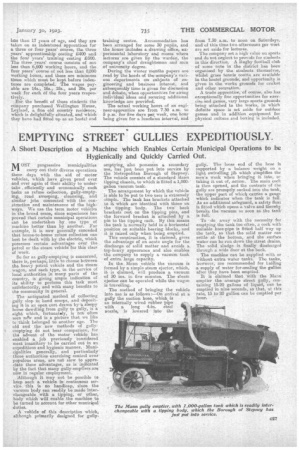EMPTYING STREET GULLIES EXPEDITIOUSLY.
Page 27

If you've noticed an error in this article please click here to report it so we can fix it.
A Short Description of a Machine vhich Enables Certain Municipal Operations to be Hygienically and Quickly Carried Out.
OST progressive municipalities carry out their diverse operations these days with the aid of motor vehicle's, which have given proof over and over again of their ability to undertake . efficiently and economically such tasks as refuse collection, gully-empty ing, road sweeping, cleansing, and similar jobs connected with the con struction and maintenance of the high ways. We use the term motor vehicles in the broad sense, since experience has proved that certain municipal operations can be undertaken by one type of machine better than by another. For example, it is now generally conceded that house-to-house refuse collection can best be dealt with by the electric, which possesses certain advantages over the petrol or the steam vehicle for this class of work.
So far as gully-emptying is concerned, there is, perhaps, little to choose between the heavy petrol vehicle and the steam wagon, and each type, in the service of local authorities in many parts of the country, is giving ample indication of its ability to perform this task most satisfactorily, and with many benefits to the community in general.
The antiquated method of collecting gully slop in hand scoops, and deposit ing it in an open cart drawn bra sleepy horse dawdling from gully to gully, is a sight which, fortunately, is not often seen nd"tv and is a picture that. we like to think belonged to another age. The old and the new methods of gully emptying de not bear comparison, for the advent of the motor• vehicle has enabled a job previously "considered most insanitary to be carried out in an expeditious and hygienic manner. Munis cipalities generally, and particularly' those authorities exercising control over populous areas, are not slow to appreciate these advantages, as is indicated by the fact that many gully-empflers are now in regular employment.
Although it may not be possible to keep such a vehicle in continuous ser vice-, this is no handicap, since the vacuum body can readily be made inter, changeable with a tipping, or other,
body which. will enable the machine. to be turned to account for other municipal duties.
A vehicle of this •description which, although primarily designed for gully
emptying, also possesses a secondary use, has just been put into service by the Metropolitan Borough of Stepney. The vehicle consists of a standard _Alarm tipping chassis, to which is fitted a 1,000gallon vacuum tank.
The arrangement by which the vehicle is able to be put to two uses is extremely simple. The tank has brackets attached to it which are identical with those on the tipping body. The two back brackets rest on the tipping pins, and the forward bracket is attached by a pin to the tipping rack. By this means the tank is normally held in a horizontal position on suitable bearing blocks, and it is raised only -when being emptied. This construction, it is claimed, gives the advantage of an acute allele for the discharge of solid matter and avoids a top-heavy appearance and also enables the company to supply a vacuum tank of extra, large capacity.
In the Mann vehicle the vacuum is formed by a simple steam ejector, which, it is claimed, will produce a vacuum of 20 ins, in five minutes. The steam ejector can be operated while the wagon is travelling.
The method of bringing the vehicle into use is as follows :—On arrival at a gully the suction hose, which is an internally wired rubber pipe with a long 4-in. steel nozzle, is lowered into the gully. The loose end of the hose is supported by a balance weight on a light swivelling jib which simplifies the men's work when bringing it into, or taking it out of, action. The main cock is then opened, and the contents of the gully are promptly sucked into the tank, the upper part of which carries a gauge indicates ndicates when the tank is full.
As an additional safeguard, a safety float is fitted which opens a valve and thereby breaks the vacuum so soon as the tank is full.
To do away with the necessity for emptying the tank too often, a cock with suitable hose-pipe is fitted half way up the tank, so that the solid matter nen settle at the bottom, and the surface water can be run down the street drains. The solid sludge is finally discharged through a wide door at the back.
The machine can be supplied with or without extra water tanks. The tanks, however, are recommended for hob:ling a supply of water forseealing the gullies after they have been emptied.
It is claimed that with the Mann emptier the average street gully, containing 15-20 gallons of liquid, can be emptied in nine seconds, so that, at this rate, 15 to 20 gullies can be emptied per hour.


































